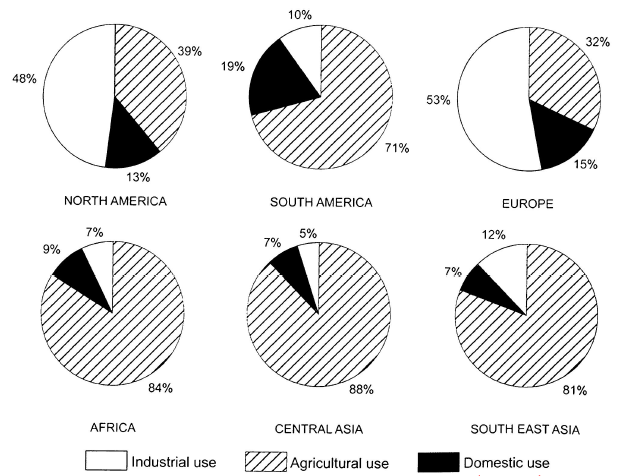Writing Task 1
You should spend about 40 minutes on this task. Write about the following topic:
The chart below shows the percentage of water used for different purposes in six areas of the world.
Summarise the information by selecting and reporting the main features, and make comparisons where relevant.
Write at least 150 words.

Writing Task 2
You should spend about 40 minutes on this task.
Write about the following topic:
Governments should spend money on railways rather than roads.
To what extent do you agree or disagree with this statement?
Give reasons for your answer and include any relevant examples from your own knowledge or experience.
Write at least 250 words.
Cambridge IELTS 11 Academic Writing Test 1 Task 1 Model Answer (212 words)
The chart illustrates the distribution of water usage across three different sectors: industrial, agricultural, and domestic in six distinct regions of the world.
In North America, water is almost equally distributed among industrial (48%), agricultural (39%), and domestic (13%) purposes. Europe follows a similar pattern with a slightly higher emphasis on domestic use at 53%, while industrial and agricultural uses are at 32% and 15% respectively.
South America stands out with its heavy reliance on water for agriculture at 71%, leaving only 19% for domestic use and a mere 10% for industrial purposes. Central Asia mirrors this trend but has an even higher dependence on agricultural water use at an impressive 88%.
Africa’s water usage pattern aligns more with South America and Central Asia; however, it has a slightly lower percentage allocated to agriculture (84%) but compensates with higher domestic use (9%).
South East Asia presents a balanced scenario similar to Europe but leans more towards domestic consumption which stands at 81%. Industrial use is minimal at just 7%, akin to Africa’s statistics.
In summary, there’s a clear divide where Africa, Central Asia, and South America are heavily reliant on water for agricultural purposes while Europe, North America, and South East Asia have more balanced distributions with significant allocations towards domestic consumption.
Cambridge IELTS 11 Academic Writing Test 1 Task 2 Model Answer (282 words)
The question of whether governments should prioritize spending on railways rather than roads is a complex one, and opinions may vary based on specific circumstances and priorities. While both railways and roads are crucial components of transportation infrastructure, the optimal allocation of resources depends on various factors such as population density, geographical features, and economic considerations.
One argument in favor of investing in railways is their potential for efficiency and sustainability. Rail transport tends to be more energy-efficient and environmentally friendly compared to road transportation. Trains can carry large volumes of goods and passengers over long distances with lower energy consumption per ton-mile or passenger-mile. Moreover, railways can alleviate congestion on roads, reduce air pollution, and contribute to a more sustainable transportation system.
On the other hand, roads are often more versatile and accessible than railways. They provide door-to-door connectivity, allowing for more flexible point-to-point transportation. In regions with dispersed populations or where the terrain is challenging, investing in road infrastructure might be a more practical choice. Additionally, roads can be crucial for economic development, as they facilitate the movement of goods, services, and people, supporting local businesses and industries.
Countries like Japan and several European nations have successfully integrated extensive railway networks into their transportation systems, promoting efficiency and reducing environmental impacts. However, in countries with vast landscapes or lower population densities, investing in road infrastructure may be a more pragmatic approach.
In conclusion, the allocation of resources between railways and roads should be based on a careful assessment of specific geographical, economic, and environmental factors. Both modes of transportation play vital roles, and a balanced approach that considers the unique needs of each region is likely the most effective strategy.
Leave a Reply